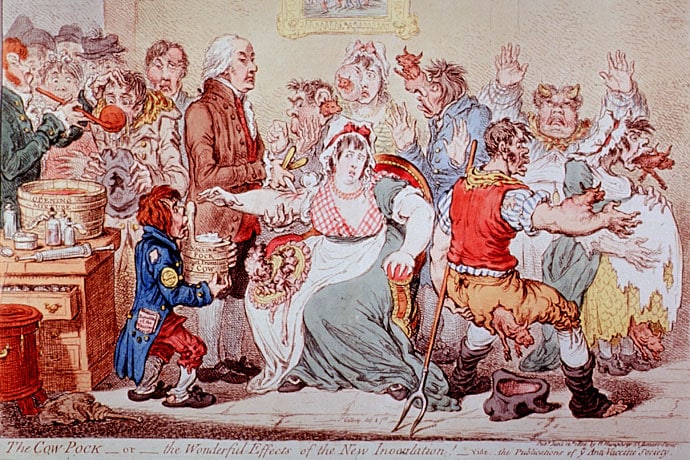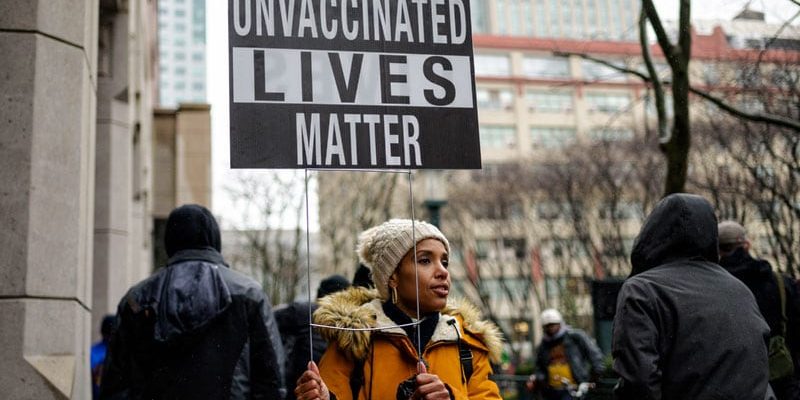This article was originally published in French on Medscape.
France ― In January 2019, not long before the COVID-19 pandemic began, Laurent-Henri Vignaud, PhD, and Françoise Salvadori, PhD, published what would turn out to be a very timely book, Antivax: Resistance to Vaccines from the 18th Century to the Present Day. In his presentation last month at the French College of General Medicine’s 15th Congress of General Medicine, Vignaud, a historian of science, gave examples from the past to show that opposition to vaccines, which has come to light during the COVID-19 pandemic, is neither a recent phenomenon nor specific to France.
A Detour Through History
If we want to put the antivaccine movement that emerged during COVID in historical context, it is important to be aware that there is nothing new about its arguments. As Vignaud put it, “For as long as there have been vaccines, there have been people speaking out against them.” In their book, Vignaud, an associate professor of history, and Salvadori, a doctor of immunology and virology, both at the University of Burgundy, France, identified four types of anti-vaccine arguments: religious, naturalist, political, and those based on alternative medicine.
“Becoming a Minotaur”
“Generally speaking, the most absolute form of ‘antivaccinationism’ is found among people who are deeply religious. Though a very small minority, there are those who refuse any and all types of vaccines,” noted Vignaud. In the 18th century, there were debates about smallpox inoculation. Some theologians were opposed to the practice, citing divine providence and the fact that one cannot go against God’s will.
In his sermon of July 8, 1722, the Reverend Mr Edmund Massey of Sussex condemned inoculation as “a Diabolical Operation, which usurps an Authority founded neither in the Laws of Nature or Religion…and promotes the encrease of Vice and Immorality.” Even physicians of the time were divided on the question of inoculation.
The years that followed saw real progress with the introduction of the technique used by the English physician Edward Jenner. No longer were his patients inoculated with pus from a smallpox lesion; instead, they were inoculated with the vaccine from a cow infected with cowpox (i.e., variola vaccinia, from which we get the word “vaccine”). Significantly less dangerous, yet providing just as much protection, this new practice spread quickly around the world, but not without encountering critics.
“This transfer of fluid from an animal to a human could, they said, bring about a transformation, turn a human into an animal.” It was putting people at risk of becoming beasts, even “becoming minotaurs,” as some illustrations at the time depicted.
Other fears, quite unoriginal and predictable, spread as well. For example, the possibility of being poisoned filled people with apprehension. This was in the wake of numerous cases of contamination caused by the so-called “arm-to-arm” technique: taking material from a pustule of a vaccinated subject rather than directly from the infected cow.
Some of the fears about that new technique were, however, justified. “While it was rare for the vaccine to transmit a ‘cow-like state,’ it was not rare for this vaccination to introduce syphilis,” the historian conceded.

Leagues Against “Vaccine Tyranny”
Vaccination had mixed results, with smallpox continuing into the 19th century. To fight this disease, countries implemented the first set of laws ever to mandate vaccination. “When vaccination becomes a political matter, resistance to vaccination does as well. And so, from 1860 to 1870, we see antivaccination leagues being established — the first of which appear in England.” These leagues against “vaccine tyranny” came about following the United Kingdom’s “Vaccination Act” of 1853, which required infants to be vaccinated against smallpox within 3 months of being born. The smallpox vaccine did not become mandatory in France until 1902, which was “quite late.”
Between 1880 and 1914, these leagues started to appear all over the world, with protests — sometimes turning into riots — taking place throughout the Anglosphere and elsewhere.
In 1885, close to 100,000 people participated in a demonstration in Leicester, England. In the 1904 Vaccine Revolt, Black workers of Rio de Janeiro mobilized in a revolt against Brazil’s mandatory vaccination. “Politicians tackle the issue head on. In England, a major debate in Parliament will result in the abolition of the 1853 law and the adoption of an amended conscience clause on vaccination starting in 1907,” allowing the recalcitrant to get an exemption. “What we’re seeing now — the recent demonstrations in France against the health pass, the Pass Sanitaire — is the next round of the issue of vaccines yet again prompting people to take to the streets,” Vignaud noted.
Anti-Germ Theory Groups
This same period also sees the birth of germ theory, or bacteriology. Joseph Lister in England, Edward Albert Koch in Germany, and Louis Pasteur in France were at the forefront of this new field, which would be the subject of various criticisms. Germ theory would be at the center of arguments against vaccines. It would be where the new ways of thinking converged.
“This new experimental science, put into motion by Claude Bernard, Paul Bert, and Louis Pasteur, relies heavily on laboratory animals for its research. This fact will lead to the creation of the animal defense league — what are, these days, animal rights movements; their efforts will be directed against Pasteur and his followers,” Vignaud pointed out.
To these can be added groups promoting feminist thought. They saw a vaccine as a destructive “patriarchal intrusion” into the bond between mother and child. In Brazil as well, women were the ones leading the antivaccination demonstrations taking place at the time.
The third group to converge was made up of workers, as the laws mandating vaccination have a particular impact on poor populations. These are the people whose vaccination status can be readily monitored, whether at the doors to the factories where they seek work or the doors of the shelters where they seek refuge.
“The last group comprises certain hygiene movements. They oppose germ theory because they consider this ‘idolatry of the microbe’ to be a bad way of looking at health. In their view, what brings about good health is behavior, the environment — not coming into contact with some microorganism, much less getting it injected into your body.”
The Modern Era: The Uniqueness of France
More than a century later, France still stands out for its distrust of vaccines. Vignaud mentioned a Wellcome Institute survey published in 2019. This was a global study of public attitudes toward science and health. One of its findings was that 45% of French respondents expressed disagreement with the statement “Vaccines are safe,” vs 14%, on average, in 67 other countries. On a world map showing the “share of people who believe vaccines are safe,” France sticks out like a sore thumb.
What Is “Antivaccinationism?”
According to Vignaud, the catchall term “antivaccinationism” can be broken down into three categories, based on intensity and nature.
First is vaccine hesitancy, the refusal of certain vaccines or the delay in getting them despite vaccination services being available.
Next is vaccine skepticism. This describes a critical attitude toward vaccines, one that may explain a person’s reluctance or refusal to follow vaccine policies.
Third, antivaccinationism in its current form stems from the adherence to one or more theories that are opposed to vaccination being used as a prophylactic.
Very Few Antivaxxers
“In their research, social scientists have tried to define and quantify the phenomenon,” Vignaud explained. One of them is Patrick Zylberman, PhD. His pyramid of doubt presents the various levels of reluctance. “The base is negligence or indifference that does not have a militant aspect to it. The middle section is suspicion and defiance regarding the product itself or its manufacturers. At the tip, total refusal of vaccine practices, is where we find the less than 2% of the population who are actual antivaxxers.”
“Coming back to the current situation,” said Zylberman, “there are still 6 million people in France who are not vaccinated against COVID-19. Polls show that a significant proportion cannot be classified as antivax. Rather, they are people who don’t have healthcare services nearby, who aren’t hearing or seeing any of the campaigns aimed at raising awareness. This is an important analysis, showing that although those who are the most radical are in the extreme minority, the broader phenomenon of vaccine hesitancy can affect a larger share of the population, up to 15/20/30%.”
For more news, follow Medscape on Facebook, Twitter, Instagram, YouTube, and LinkedIn
Source: Read Full Article
